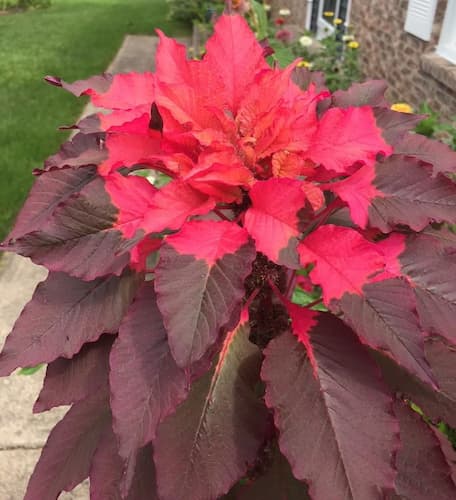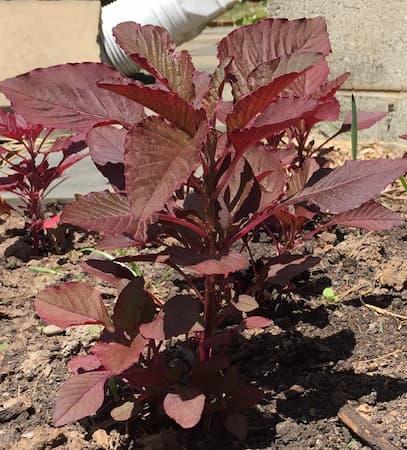How to Grow Amaranth Flowers

About Growing Annual Amaranth Flower Plants
Annual Amaranth flowers are an easy-to-grow flowering plant. Even first-time gardeners will find growing Amaranth is both easy and rewarding. If you are looking for dried flowers, you’ve come to the right plant. Amaranth flowers keep their color after they are dried. They make perfect dried flower arrangements. That’s why the ancient Greeks named this plant for the Greek word for “unfading”. The plant produces tens of thousands of amaranth seeds over the season.
The amaranth family includes flowers, herbs, and weeds. Some varieties are grown and harvested for food. The seeds of the “Grain Amaranth” were harvested by Aztec and Inca tribes in Central and South America. In Asia and South, America Amaranth is cultivated as a grain crop. In the U.S., it can be found in health food stores.
Their bright, long-lasting flowers will attract butterflies.
Annual Amaranth Plant Specifications
Flower colors include: Amaranths come in a variety of colors, including shades of pink, lavender, and white.
Most Popular Varieties: Autumn’s Touch, Copperhead, Green Thumb, Joseph’s Coat, Molten Fire, Red Amaranth, Tri-color Perfecta
Plant height: Most common flower varieties grow 1′-2′ tall. Some bush varieties will grow up to 4′-6′.
Plant Blooms: Summer through Fall.
Sunlight Requirements: Full sun to partial shade
Soil Requirements: Average soil, moist well-draining
Hardiness Zones: 5 – 9
Ideal Soil pH: 6.0 – 6.5.
Native to: North and South America
Other Names: Love Lies Bleeding
Annual, Amaranthaceae
Are Amaranth Seeds and Plants Edible?
Yes! Both the seeds and the leaves are indeed edible.
Amaranth seeds are edible and popular, too. It is a grain crop in South America and some other areas. Amaranth seeds are high in iron, calcium, and other minerals. They are a good source of protein and fiber. The seeds are gluten-free, too. Also, the seeds can be popped like popcorn.
The leaves have a sweet and nutty flavor. Try the leaves in salads, stews, and soups. Use them in recipes in place of kale or spinach.
Health and Medicinal Benefits of Amaranth
There are several health and medicinal benefits from eating Amaranth seeds and leaves.
Among them are:
- Amaranth lowers cholesterol.
- It has antioxidants.
- Prevents and slows the aging process.
- Amaranth is good for diabetics and weight loss.
- It is gluten-free.
- It is good for hair and skin health.
- The plant and seeds promote bone health.
Note: Consume the seeds in moderation. Avoid eating raw amaranth seeds. Also, overconsumption can cause bloating and stomach discomfort.
Annual Amaranth Plant Propagation
Amaranth plants are grown from seed. Directly sow Amaranth seeds into your flower garden, or start indoors for transplanting later.
Important: Amaranth plants are susceptible to frost. Amaranth prefers warm weather. If planting outdoors, sow Amaranth seeds after the soil has begun to warm in the spring.
We recommend an indoor start, six to eight weeks before the last frost in your area.
Sow seeds early in the season and cover lightly with soil. Space seeds or seedlings 10-12″ apart. They will tolerate a little crowding, and look good in clumps or groups.
Did you Know? A single mature bush can produce 40,000-60,000 Amaranth seeds!
Seed Germination: 3 – 15 days

How to Grow Amaranth Flower Plants
Growing Amaranth is very easy.
Originating in warmer climates, Amaranth is heat and drought-resistant.
The plants grow best in full sun. However, the plants tolerate partial shade.
Amaranth does well in average, but well-drained soil. Mix in some compost at planting time.
Water the plants once or twice per week during dry periods. Allow the top of the soil to dry out between watering.
In rich to average soils, fertilizer is not needed. In poor soil, add a general-purpose fertilizer once or twice a season.
Apply a generous layer of mulch around the plants for a neat appearance. Mulch will also keep the weeds down and help retain soil moisture.
Amaranth will grow tall. So, place them toward the back of the flower garden. They produce blooms on strong, straight stems. Flowers are long-lasting and will bloom from midsummer until frost.
For dried flower arrangements, pick mature blooms and allow them to dry in a cool, dry, well-ventilated area. The dried flowers will retain their color and will brighten up a room all winter long.
Insects and Plant Disease
Amaranth is resistant to insects and disease. Mildew problems may occur in warm, humid weather. If insect or disease problems occur, treat problems as soon as they appear. Use organic or chemical insect repellents and fungicides. If you are going to eat the leaves or seeds, avoid chemical insect and pant disease controls.
Also See: Plant Problems – causes and cures
Related Articles
People who read article also like:
How to Grow Amaranth Plants – let’s get growing!
Please support our site. Shop for:
- rmmatthews100@hotmail.com
- 585-721-6528
- Rochester, NY
©1999-2024 GardenersNet.Com, All Rights Reserved

